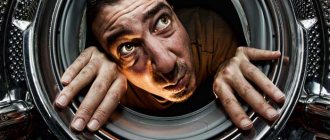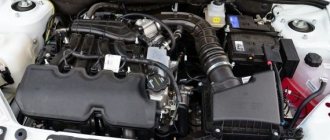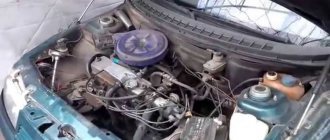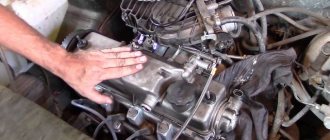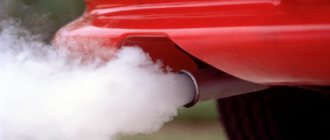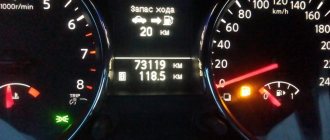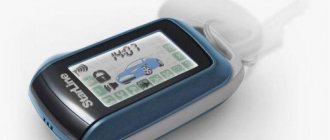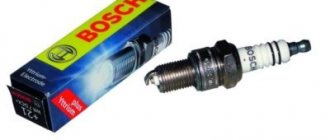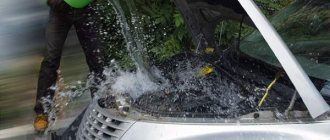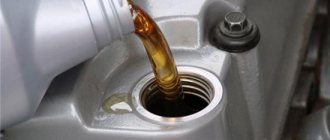Lost engine thrust on VAZ 2114 (8 valves, injector) - TOP 10 reasons
Unfortunately, many owners are familiar with the situation when the traction on a VAZ 2114 (8 valves, injector) suddenly disappeared. There may be many reasons for this, but the main ones are 10. And not all of them are related to the fuel system or sensors. Sometimes there are more serious problems. From this article you can learn the main causes of this phenomenon, their signs and methods of detection.
Spark plug
The first thing worth checking when looking for the reasons for floating speed on a VAZ 2114 (injector) is the spark plugs. Unscrew them and inspect their condition. They should not be oxidized, uneven soot, oil, etc. They should have a brown or gray-brown soot, without any deposits. If so, the spark plugs are in working order. In cases where the replacement took place a long time ago, it is more advisable to immediately replace them with new ones, regardless of the condition. Remember that spark plugs need to be replaced every 20-30 thousand kilometers. If a warmed-up engine returns to normal operation, then this is another sign to look for a problem in the spark plugs.
Doesn't respond to the gas pedal. VAZ 2114
to 92serega9229: did you adapt the throttle?
turn on the ignition and wait 1 minute, turn off, start
I encountered such a problem, the VAZ 2115 reacts to pressing the gas pedal after 5 seconds and when the pedal is pressed to the floor it picks up speed very slowly, it also stalls when downshifting, the engine also very quickly reaches operating temperature, and after parking, I discovered that the antifreeze had boiled.
By process of elimination we realized that the problem was not in the engine, not in the throttle sensor, not in the air flow sensor, not in the gas tank mesh, not in the fine filter. Does anyone know what this could be?
VipeRUS34:
The engine reaches operating temperature very quickly, and after parking, I discovered that the antifreeze had boiled.
The catalyst is completely clogged. (if installed) The timing marks are knocked off.
I had the same bullshit
I press on the gas, the engine is running, but it seems that the cable has broken, it turned out that the generator was giving a weak charge. We replaced the bridge and brushes on the generator and everything is OK.
Work 800r. spare parts 900r. Good luck to all.
And what does the generator have to do with the gas pedal, you’re thinking wrong, there’s no connection
Tell me, VAZ 2114 8th class 2011!
I start it up, it idles perfectly, but the gas pedal doesn’t respond at all, as if I’m not pressing it! I’ll turn it off and start it back to normal, but not for long then again! She can hold it at 2000 rpm herself, while still not obeying the gas pedal!
The check light is on, I took it for diagnostics, they said the throttle valve, changed it, nothing changed!
to Auto(grandfather):
Hello, I have the same problem: the rpm hangs at 2000, the pedal does not respond and the check light is on. Auto VAZ 2114 2012 electric pedal, according to many recommendations, a lot has already been replaced: air filter, throttle body, air flow sensor, spark plugs, armored wires, fuel filter, generator damper pulley (the rubber was cracked) with an iron one from crankshaft position sensors, but the problem does not change nothing and keeps appearing, what can you tell me?
VAZ injection engines
In injection engines VAZ-2110, 2112, 2114, 2115, both 8-valve and with a timing belt with 16 valves, it is more difficult to identify the cause of the decrease in power due to the more complex design of the main systems.
Supply system
Any injector consists of a mechanical executive part and an electronic control part, and problems can arise in both of them, which will lead to a drop in power.
Let's look at the mechanical part first. Here, cravings can be influenced by:
- Severely clogged mesh filter on the fuel pump;
- Decrease in fuel pump performance due to wear;
- The fine filter is dirty;
- Malfunction of the fuel rail pressure regulator;
- Clogged injectors;
- Fuel filter dirty;
- Air leak in the manifold.
Features of failures
What all pedal failures have in common is that when you press the pedal, the engine does not respond in a timely manner, and therefore does not gain momentum. Such failures can appear in different situations and the behavior of the machine can also be different.
So, we can highlight:
- Short dips while driving (no more than a couple of seconds) followed by a quick response from the engine.
- Dips during acceleration.
- Dips at idle speed.
- Prolonged failures, as a result of which the car stalls.
- Jerking, characterized by a series of alternating short dips and subsequent jerks.
There are not many reasons for this phenomenon, so finding and eliminating them will not be difficult for an experienced driver.
In 99% of cases, failures can be caused by one of the following reasons:
- clogged injectors;
- damage to the fuel system;
- injector damage;
- wear of temperature sensors;
- errors in the ECU;
- failure of spark plugs.
If you notice even minor changes in the “behavior” of the engine, you should end the trip as quickly as possible and visit a car service center or perform independent diagnostics and repairs. Continuing to drive a car with dips is not only harmful to the car itself, but also extremely dangerous.
SIGNS AND REASONS OF “ADJUSTMENT”
Signs:
Engine trouble: what is it, and what are the signs to identify this malfunction? You can understand that the internal combustion engine is malfunctioning by the following signs:
- At idle speed, the engine operates unevenly, jerking periodically;
- The car does not develop the required power when driving;
- The car drives jerkily, when you press the gas pedal, there are gaps in operation;
- The exhaust from the muffler is uneven, with interruptions, pops and shots are possible;
- Fuel consumption increases.
Increased fuel consumption hurts your pocket Reasons: There are many reasons why the engine misfires. There are such nuances that even experienced technicians do not immediately determine the nature of the malfunction. But the most common cylinder failures are the following (starting with the elementary ones):
- The candle does not work;
- The high-voltage wire is broken;
- The ignition coil has failed;
- The control unit is faulty;
- There is an air leak in the intake manifold;
- Exhaust valve burnt out;
- The cylinder head gasket is broken;
- The compression rings on the piston are broken,
- The piston itself has burned out, or the bridge on the piston between the compression rings has burst.
This article is about the VAZ 2114 car, so carburetor malfunctions are not considered, since this device was not installed on the 2114 model. This brand of car has a fuel system with distributed injection (injector), and the answer to the question of why the engine stalls may be hidden in this system.
Dips during acceleration
Most often, in the VAZ 2114 car, failures when pressing the gas injector occur during acceleration.
If you are faced with a similar situation, then the search for its problem should be carried out in the following sequence:
- If the spark plugs are oxidized or covered with soot, they should be cleaned with a cloth with kerosene or fine sandpaper (or replaced if they cannot be restored). In addition, the composition of the fuel mixture should be adjusted, since very often the cause of soot on the spark plugs is precisely its incorrect composition.
- Check the condition of the armored wires (to do this, their insulation should be measured using a megohmmeter and, if necessary, replaced with new ones).
- Check the condition of the throttle valve. If it is contaminated with plaque, it should be thoroughly cleaned (even a slight layer of plaque greatly affects the proper operation of the damper).
- Check the condition of the air filter, and in case of severe contamination or damage, replace it with a new one (it is worth remembering that the filter directly affects the correct composition of the combustible mixture, and therefore it should be checked periodically even during normal engine operation).
- If, after completing the above steps, the cause could not be found, then you should dismantle the fuel pump and check its functionality. At the same time, the fuel filter should be checked and, if necessary, replaced.
- Check the computer for errors (this can be done using a diagnostic computer. If it is not available, you will have to contact a car repair shop).
- Conduct diagnostics of the injectors and, if necessary, clean them (clogged injectors are the most rare cause of failures, but at the same time they are quite difficult to do on your own. If you cannot clean them yourself, you will have to contact a car service).
If on your VAZ 2114 failures occur when you press the gas injector while driving, then using the above plan you can easily find the causes of this phenomenon and be able to eliminate it.
Where to begin?
When you first have problems accelerating a car, you should start checking the car with the fuel system. The most common breakdown of a car's fuel system is the fuel pump, and it makes no difference whether it is mechanical or electrical. Both the first and the second are equally likely to fail at the most inopportune moment.
Difficulties with the pump may appear after a while. The car can slowly reduce its speed characteristics, and when this process reaches a noticeable state, you will understand why the engine does not gain speed.
The problem is the fuel pump, which, although it has not yet failed, is no longer actively supplying fuel to the engine. This inevitably leads to fuel starvation of the car, and, as a result, loss of power.
- You should start checking the ignition with the timing marks. It is the correctness of their installation that determines how timely fuel injection and spark supply will be.
- If the marks are in order, you should pay attention to the numerous sensors, which are plenty for an injection engine. You can check the crankshaft position sensors, camshaft position sensors and others yourself or entrust the car to a specialist.
- If everything is fine here, it’s worth paying attention to when the timing belt or chain was changed. The reason why your VAZ does not gain speed may be due to incorrect installation of the belt. Here it is enough to make a mistake by one tooth, and you can safely forget about normal acceleration of the car.
The 406 engine may not gain speed due to the fault of the injector, and the problem will be divided into two:
- the car won't start at all;
- the car does not work properly (this includes problems with speed, both while driving and idling, as well as all kinds of jerking of the car).
In the first case, the “nine” is often helped by warming up the battery or even recharging it. As you might guess, this situation occurs in winter during frosts. The reason lies in the decrease in battery capacity, which may simply not be enough to start the engine.
The second way to revive a frozen car is to supply hot air through a hair dryer. This “folk” method also helps many.
And finally, the third reason why a car may not start is faulty spark plugs.
Methods for diagnosing the problem
For the most accurate diagnosis, you will need to use a diagnostic tester, a fuel rail pressure gauge, a vacuum gauge and a spark gap.
- The first thing to check is whether the engine is controlled by the ECU. To do this, simply turn on the ignition and listen to whether the fuel pump makes noise.
- Then we look at the fuel line pressure. Data at the level of 2.5 - 3.0 kg/cubic centimeter are considered the norm.
- If these parameters are normal, you can check the BITSTOP parameter using the diagnostic tools while cranking the crankshaft. The BITSTOP parameter must be set to "no". This indicates that the ECU receives a command to start forming a spark on the spark plugs and is fully operational.
- By connecting a high-voltage spark gap, you can check whether there is a spark at all, and perhaps the cause is poor-quality spark plugs.
Also find out how much oil to fill in the engine and about flushing the engine before changing the oil.
Air supply
The air supply can also cause poor vehicle traction. If more air enters than it should, the composition of the fuel mixture will be disrupted. Those. there will be more air and less fuel, which will lead to a drop in thrust.
The simplest solution is to replace the air filter, which is recommended to be done every six months.
If the engine speed increases, but the speed does not gain, the reasons may be:
- low pressure in the fuel system (as mentioned earlier);
- problems in the operation of the mass air flow sensor;
- air filter clogged;
- coked nozzle.
It is more difficult to understand the operation of the mass flow sensor, since each car must have its own parameters, and you will still need the appropriate equipment. Even a deviation from the norm of 3 kg/hour can cause significant “changes” in engine operation, and not for the better. Using the 406 engine as an example, we can say that the norm is 13 - 15 kg/hour. At the same time, reducing the flow to 11 kg/hour will lead to such a problem that the engine does not gain speed or does so slowly, while increasing this figure to 19 kg/hour will significantly increase fuel consumption, and this is also unpleasant.
Coking of injectors is most often the result of low-quality fuel, since problems with the “electrical” part arise extremely rarely. To check, they often turn off the injectors one by one, while monitoring the drop in engine power. The norm is approximately 110 revolutions.
Dips at idle
Sometimes it happens that when you press the gas pedal, a drop in the speed of the VAZ 2114 occurs at idle (and most often when starting off). The reasons for this phenomenon are quite similar to the reasons for failures in movement.
Let's consider a plan for finding and eliminating them:
- Check the condition of the spark plugs and the gap size. Clean them (how to do this was discussed above) or replace them.
- Check the condition of high-voltage wires.
- Replace the fuel filter (and if the replacement does not help, check the operation of the gasoline pump).
- Check the functionality of the temperature control sensor and idle speed sensor. If they turn out to be faulty, replace them (there is no point in trying to repair the sensors, since they are not repairable).
- Check the electronic unit using a diagnostic adapter and delete errors if any.
- Completely replace the fuel with gasoline from another gas station (very often low-quality fuel causes dips and jerking at idle).
- Carry out diagnostics of the injector.
- Check the condition of the injectors and clean them if necessary.
Troubleshooting options
It is clear that if any emergency situations arise with the motor, it is advisable to contact a specialized service. However, this procedure is not always possible. Therefore, it is worth knowing how to independently diagnose the main systems and key parts.
Throttle valve and assembly
When the speed drops at idle and the car stalls, you need to pay close attention to the details of the throttle assembly. Long-term operation of the car on low-quality fuel and untimely maintenance of the air filter can lead to malfunctions of the throttle valve. It periodically jams if debris gets into the equipment
It periodically jams if debris gets into the equipment.
Throttle valve VAZ 2112
The problem can be solved by cleaning the system. The throttle is cleaned using carburetor cleaners. Using a compressor, you need to blow out the damper under the pressure of compressed air. It is not recommended to touch the screws located inside and on the side. If cleaning does not correct the situation, the device must be replaced. This operation is not particularly difficult.
Crankcase malfunction
There is an oil trap in the crankcase ventilation system of the engine. Its contamination can also lead to interruptions in engine operation. Crankcase gases do not allow the engine to function normally, the speed fluctuates, the internal combustion engine stalls.
Sensors
If a gasoline car stalls at idle, then one of the sensors is likely to break. In injection cars with an electronic engine control system, the engine usually starts normally, but then it stops working. It's worth checking here:
- Electronic car indicators;
- DRХХ – device that regulates idle speed;
- Air flow meter (air intake in the carburetor);
- Sensor indicating the position of the throttle curtain.
Electronic control unit in VAZ 2114
Interruptions in the operation of any sensors immediately affect the behavior of the electronics - errors appear in the car control unit. The “brains” of the machine receive unreliable information. It is not transmitted correctly to the engine. It starts working with parameters that do not correspond to reality. Self-testing of this device is not possible. You need to contact a professional for service.
Diagnostics of mass air flow sensor
The idle air control device is usually to blame for engine malfunction when the car idles poorly. But you pressed the gas pedal and the engine started. In the latest VAZ modifications, error information appears on the instrument panel.
When diagnosing, you must use a multimeter. If a part is faulty, it is recommended to replace it with a new one. All sensors are reasonably priced. It is better to start checking with parts that have a simpler design. Then gradually move on to complex devices. We must not forget that the problem may lie not only in the sensors themselves. It is also necessary to check the wiring to them and the presence of stable contact.
Carburetor
If the VAZ carburetor stalls at idle speed, then the jets may become clogged. Low-quality gasoline, deposits from the gas tank, contain small particles of debris. They can easily disrupt the operation of the fuel injection system. It is worth replacing the filter in front of the carburetor and cleaning the device itself. The dispensing part is cleaned using a cleaning solvent, which is sold in aerosol cans. Another reason is often a prolonged lack of carburetor adjustment.
In a mechanical fuel pump of carburetor cars, the filter mesh may be clogged with dirt. This reduces the performance of the device. Wear of the membrane and its destruction often leads to clogged carburetor channels.
Injector
A situation that often arises is that various Lada models, as well as the VAZ 2110 injector stalls at idle. It is necessary to check the fuel pump strainer for clogging. This is a common problem with injection machines. It is better to immediately replace the part with a working one.
Filter problem
If the VAZ 2112 stalls at idle, then the fuel filter may be dirty. This also applies to other models of the concern. Generally, it is not practical to clean it. The part must be replaced. The same should be done with a dirty air filter. Low throughput leads to the fact that the air-fuel mixture simply floods the spark plugs.
Self-checking will not always lead to a positive result. It is often more practical to identify the cause of unstable operation of the internal combustion engine at a car service center. It will cost more, but specialized diagnostics will prevent more serious damage to the car.
How to Avoid Failures
Having talked about how to eliminate gas pedal failures that occur on a car, it is worth talking about how to completely avoid their occurrence. So, the most common cause of their occurrence is wear of the spark plugs. Therefore, you should always check their condition, prevent clogging and oxidation, and, if necessary, replace them.
It is worth remembering that it is highly recommended to replace spark plugs as a “set”, even if only one of them is seriously damaged.
In addition to spark plugs, high-voltage wires should also be periodically monitored (despite the fact that they have a long service life, core breaks and breakdowns of protection are far from uncommon).
Another very common cause is clogged filters, and especially the air filter. This element is a direct participant in the chain of formation of the working mixture, and that is why its contamination (or even damage) can immediately affect the operation of the engine.
The last thing you should pay attention to in order to avoid unpleasant gas failures is the quality of the fuel. If you notice that at the nearest gas station it has dropped significantly (and the car reacts to this), then you should not continue to use it - it is better to try refueling at a pump of another company (or several companies). In this way, you can find the highest quality gas station and ensure reliable operation of your car’s engine.
How to fix the problem?
The way to eliminate problems that arise is to replace damaged or worn parts.
It is better to correct such defects in a specialized service, where they will first clarify the cause of the problem.
Some causes of misfires in the VAZ 2114 can be found and eliminated yourself:
- If gaps and error 300 appear on the computer screen, you need to unscrew all the spark plugs, check the gap between the electrodes and see if there is a lot of carbon deposits on their surface. For errors like 0301, 0302, etc., you need to pay special attention to the condition of the spark plug in this cylinder.
- It is necessary to visually inspect the wires leading to the spark plugs; if cracks are found on the surface, they should be replaced with new ones.
- Check the condition of the camshaft drive belt and the alignment of the marks on it. If the phases are violated, it is necessary to adjust the gas distribution system.
- Check the compression, which should not be lower than 10 and not higher than 14 Bar and should not have a spread across the cylinders of more than 1 Bar. If the pressure is low, it is necessary to check the valve clearance adjustment.
- Check the clearances in the valve mechanism. Sometimes when adjusting, the clearances are set incorrectly and the exhaust valves do not close completely. Monitoring and adjustment of clearances must be carried out every 20 thousand km, and when using gas as fuel - after 10 thousand km.
- If there are misfires in different cylinders that occur under different operating conditions of the unit, the ignition module must be replaced.
Gas disappears while driving VAZ 2114
Messages: 279 Registered: Mar 14, 2011, 00:00
Thanked: 2 times
Posted by daseros » April 19, 2012, 10:17 am
What the heck is a gearbox on a front-wheel drive? Check the pump, spark plugs, wires and fuel pressure regulator. And of course all the meshes and filters
Added after 2 minutes 1 second:
clutch when you squeeze the gas, that is, I don’t understand? If there is a stable one, then the clutch is screwed
Repair of the chassis of FOREIGN CARs and VAZs (front-wheel drive on the VAZ)
It’s better to write to Kara in advance in a personal message
Messages: 284 Registered: Dec 09, 2009, 00:00 Experience: From an early age. Auto: favorite
Message 777KoT777 » April 19, 2012, 11:17
Messages: 211 Registered: May 24, 2011, 00:00 Experience: since 2007 Car: 2114
Post by Mushanya12 » April 19, 2012, 11:30
Messages: 662 Registered: July 10, 2006, 00:00 Experience: since 1986 (1.2 million km) :
| Rating: 2 912 |
| Reputation: +4 | Thanked: 16 times Thanked: 37 times Post by serglion » Apr 19, 2012, 11:35 am What fuel pump? The person writes that he is losing gas, not gasoline. Messages: 394 Registered: Dec 26, 2011, 00:00 Experience: 2005 Car: 2114 | Thanked: 14 times Thanked: 16 timesVAZ 2114 loses gas while drivingPost by OperCot » June 15, 2022, 11:14 am Something similar happened: there wasn’t enough gasoline at speed and the car suddenly seemed to stall, but not completely. like a cutoff. Moreover, there seems to be a speed limit, but as soon as it occurs, it continues at a speed slightly lower than the speed at which it occurred. in my case, the gas filter with wide tubes, inserted in place of a previously “foreign-made” (and we didn’t have ours) gas filter with thin tubes, “did not fit” - the tubes (inlet, outlet) resembled a pen chewed by a first-grader. as an option, a fuel pump (can be adjusted with gaskets), an overheated fuel pump (put a wet rag on top, wait, then drive), a pinched gas hose, etc. (I’ve even seen people have a return line - it’s from the carb back to the tank, but for some reason it was pinched) The accuracy of this econometer is very mediocre. For example, I have an optimum for it at 4th - about 70 km. But in fact, it is impossible to accurately monitor the flow rate based on the vacuum in the manifold. The economizer is just a toy. On the 10th I compared it using the MK - 90-100 km - it makes absolutely no difference whether it is 4th or 5th gear. The consumption is the same. And the consumption is really minimal at 70-80 km/h, but mainly due to the aerodynamics. square muzzle resistance. I can’t say for sure, because for this you need to measure it instantly, but during normal driving, I think it’s about the same. IMHO, at high speeds, in principle there cannot be a large vacuum in the manifold. Hello. While driving, the gas pedal traction disappears, in any driving mode. It feels as if I just took my foot off the pedal, but it’s there and if you press the floor, there’s 0 attention. And if you keep it this way until it stops, then after 10-15 seconds it returns to normal. Or release the pedal and immediately press it, then it starts driving, 2011, with an electric pedal
Check the opening angle (operating parameters) of the damper and the angle of the gas pedal using a diagnostic scanner at the time of the malfunction, also check the throttle valve and gas pedal connector. I also came across this option at a VAZ. The malfunction appears from time to time, but... there are no errors. After some checks and tests, it turned out that the mass air flow sensor was “dying”, it was replaced and the “glitches” were gone. There you need to measure the voltage on the signal wire (from 0.99V to 1.02V - the sensor is working, 1.03V - its service life is ending and there may be temporary fluctuations, if the readings are higher, then it is practically no longer suitable for work). measurements with the ignition on. There is a simpler way: turn off the DPKV and do a test run; If the situation improves, the sensor will be replaced. Subscribe to our channel in Where are the masses of the VAZ 2114? The starter does not work on a VAZ 2115 What is the normal charging voltage for a VAZ 2115 battery? |
Video “Causes of misfires”
The main causes of misfires are shown in the video from the Car-Hobby channel.
Do you have any questions? Specialists and readers of the AUTODVIG website will help you ask a question
Was this article helpful?
Thank you for your opinion!
The article was useful. Please share the information with your friends.
Yes (100.00%)
No
X
Please write what is wrong and leave recommendations on the article
Cancel reply
Rate this article: ( 4 votes, average: 5.00 out of 5)
Discuss the article:
VAZ 2114 check light comes on, traction disappears
In the morning I left for work, everything was ok, after work I came down from the bridge, green, first and nothing @((, as if I was pulling 8 Kirov residents, there was no traction, gas to the floor and empty, somehow I got to the house and stood in the middle of the street ((, first since it’s such crap, I unscrew the spark plugs, white coating, trouble, sadness, poor mixture ((too much air, not enough gas ((dmrv? fuel pump? injectors? wires? spark plugs, sensors? even moreover, it has already started to wobble at idle speed 600-700-800, ON first and it stalls as and when you press the clutch at an intersection (I checked the fuel pump and filter, traction appeared but the sausage did not go away, the check appeared and disappeared, it did not blink, but it disappeared, I cleaned the throttle sensors, pulled the chip off the throttle sensor and stopped stalling) but the speeds were the same and remained. I bought the DPZ and DHX, changed it right at the store, revved it up to 3000 thousand, turned it off and turned the key back to start.
everything is ok, the watch))) The check light came on ((I waved the old high-voltage wires, threw off the terminal, smoked a lot, thought a lot, put it on, started it and everything was back to normal, happy, went home to wash, fix the passenger handle, change the light bulbs in the PTF, such a weekend For the money, dpdz250, dxx740, fuel pump 1200, rubber filter, mesh 250)) Smooth roads and full tanks to everyone!
A problem has arisen with the car, help me figure it out, when accelerating after 3000 rpm, the “Check engine” lights up and the traction disappears ((((and if you don’t turn it even goes out over time. The engine trembles when this problem happens, after restarting the engine it’s normal, but again only up to 3 thousand P/s for diagnostics I need to know myself until the opportunity arises
As a rule, during the long-term operation of a vehicle, almost every driver sooner or later notices that the engine does not pull well. In other words, the power unit has difficulty coping with the loads, there is a loss of power, the unit needs to be cranked up to high speeds to maintain the usual pace, the car accelerates worse from a standstill, picks up speed slowly, etc.
At the same time, in many cases the engine runs smoothly, does not tremble, there are no increased vibrations, extraneous sounds, knocking or noise during operation of the internal combustion engine. Let us note right away that there is a fairly wide list of possible reasons why a warm engine does not run, and there is a loss of engine power when cold and/or when hot.
In this article we will talk about why the engine does not pull, and also consider the most common malfunctions that manifest themselves in the form of loss of traction of the power unit.
Read in this article
Other reasons
Finally, we note that some reasons are very rare and can be considered specific.
These include loosening the exhaust manifold, although initially it may seem that this cannot affect the engine.
In fact, on many cars, heat from the manifold is used to warm up the air entering the cylinders, and for this purpose a special screen is used, to which the air duct fits.
So, if a breakdown occurs and the exhaust gases break out, then most of them will enter the cylinders again through the air duct, and due to a lack of air, the power will decrease.
Also, the reason may lie not in the engine, but in the transmission elements, especially for cars equipped with automatic transmission.
Malfunctions in the box lead to the creation of excessive load on the engine, which will be perceived as a loss of power.
The engine does not pull: the main reasons for the decrease in engine power
So, if no other symptoms other than loss of traction are detected, then you immediately need to pay attention to the quality of the fuel, the proper functioning of the ignition and power systems.
- As practice shows, more than half of the cases of reduced efficiency from internal combustion engines are associated with fuel. The engine does not turn on due to the fact that the tank may be filled with low-quality or unsuitable fuel for this type of engine (for example, 92-grade gasoline instead of 95-grade gasoline).
Typically, such manipulations are necessary when, parallel to the loss of traction, unstable operation of the internal combustion engine is noted, the speed jumps or floats at idle and under load, the engine does not start easily, the “check” light is on the panel, etc.
Also, owners of gasoline engines can independently determine the quality of gasoline by the spark plugs and their appearance. To check the spark plugs you need to unscrew them from the engine. A disruption in the combustion process of the fuel-air mixture in the cylinders, as well as the presence of impurities in the fuel, can be identified by soot on the spark plugs and its color.
For example, if the fuel contains a lot of third-party metal-containing additives and additives, then the skirt and electrodes may become covered with reddish soot (brick-colored). Black soot will indicate that the fuel is not burning properly, etc. In any case, malfunctions in the combustion process of the working mixture lead to the fact that the engine stops pulling.
- The next step in diagnosis is checking the spark plugs. A decrease in the efficiency of these elements is also accompanied by a decrease in the power of the power unit.
This is especially noticeable during sharp accelerations, and when the car is already moving at high speed. In other words, the motor has no “reserve” left for further acceleration.
The candles may be dirty, and it is also possible that their life has come to an end. To fix this problem, you can clean the spark plugs or immediately replace the entire set with a new one.
- If everything is in order with the spark plugs, then you need to check the condition of the fuel and air filters. In the first case, insufficient throughput can lead to the fact that the required amount of fuel is not supplied to the cylinders to prepare the so-called “power” mixture.
As a result, the engine loses power, that is, it does not pull under load. In such a situation, it is enough to replace the specified filter element. As for the air filter, the problem is similar to the fuel filter, but in this case there is a lack of air in the fuel-air mixture.
This leads to the fact that fuel without a sufficient amount of oxygen burns incompletely. In such conditions, engine power naturally drops, carbon deposits form in the combustion chamber, spark plugs become increasingly dirty, etc. To solve the problem, the engine air filter also needs to be replaced.
List of reasons for power loss
The fuel filter is dirty:
Gasoline with various additives in the form of debris, rust, wool passing through the filter, settles in it and clogs the channels. As a result, poor throughput makes it more and more difficult for the engine to pump fuel. Only complete replacement of the filter elements is necessary. Contamination can only be determined by eye. Read more in the article: “List of reasons that the fuel filter is clogged.”
Malfunction of the mass air flow sensor:
Perhaps the most common problem that causes the mixture to become rich or lean. You can test it in the following way: disconnect the terminal on the sensor and start the engine, a red lamp will light up on the display, indicating a breakdown in the system, no big deal.
The speed will increase significantly to 1500-2000 rpm. try driving a few hundred meters, if the car is the same as before, then buy a sensor at the nearest store. The reason for this is untimely replacement of the air filter.
The fuel pump diaphragm is clogged:
As is the case with filters, the cause is dirty gasoline. To clean, simply unscrew the fuel pump cover bolt, remove the diaphragm and clean it. Read about the signs of a faulty fuel pump.
Air filter clogged with dust:
The element can be compared to a person’s lungs; accordingly, the dirtier it is, the more difficult it is to breathe. If you don’t have a new filter at hand, but you need to drive further, you can take the filter out of the casing, blow it a little, and tap it on a hard surface. This way, some of the dust and dirt will be removed, and you can proceed further. You should carefully inspect for the presence of dry leaves, insects, and moths. Since only large obstacles can block the air supply.
Candles are fiddling:
Due to poor quality or significant wear, sometimes the spark charge “slips”, the fuel does not ignite fully, and the combustion chamber is literally choked with gasoline. It can be eliminated by completely replacing it with a new set or unscrewing everything one by one and looking at the color.
Typically, black or wet asphalt indicates excess gasoline and insufficient combustion. It is necessary to wipe with a dry cloth, preferably with “0” sandpaper and screw it back in. Getting to the nearest auto shop is all it takes to fix it. See Signs of Bad Spark Plugs.
Low compression in cylinders:
Boiling due to systematic overheating and high wear can cause a sharp drop in compression pressure in the engine. Which leads to the consumption of motor oil in large volumes, incomplete combustion in the chamber, air leaks, and gasoline getting into the oil pan. Here, improvised means will not help. The engine must be overhauled. It can only be determined by the presence of a mixture of fuel and oil on the dipstick. The article “How to check compression in cylinders” can help.
System failure in the on-board computer:
Factory defect or random computer glitch. There is only one way out - to get to a service station by any means and carry out diagnostics. It is not recommended to repair the firmware yourself, as this should only be done by a qualified specialist.
Injectors clogged:
The situation is also common and has two solutions. The first is a trip to the service station, the second is to get to the nearest car store and purchase an injector cleaner. Typically, this is a liquid in a bottle designed to be poured into a tank. While driving, passing through the fuel channels, it cleans them of various dirt and rye. The engine acquires the same dynamics and throttle response. But the product may not always be effective, it all depends on the degree of contamination.
- “How to check injectors”;
- “What should I use to clean the injectors?”
Of course, it is impossible to list all the reasons and answer why the VAZ 2114 engine does not pull. Because the most incredible and unusual situations happen in life. But every driver should know the main reasons so as not to get confused along the way and not find himself helpless.
Malfunctions of the power supply system, ignition and impaired mixture formation
While problems with spark plugs and filters can be identified on the road, more serious problems associated with the power and ignition system are much more difficult to diagnose and fix on site. In cases where the engine does not pick up speed, and jerks and dips are noted when pressing the gas pedal, it is necessary to check and adjust the carburetor or injector.
Let's focus on the more common electronic injection. The list of main malfunctions of modern injection internal combustion engines includes:
- malfunctions, decreased performance or contamination of the fuel pump mesh filter;
- malfunction of injection nozzles;
- problems with ECM or ECU sensors;
- ignition system malfunctions;
- air leaks and leaking fuel lines;
Often, on many cars, problems are associated with the fuel pump, which is located in the gas tank, as well as with the specified regulator. To measure fuel pressure, a pressure gauge is connected to the rail; the obtained values are compared with those recommended for a particular engine. If the pressure is below normal, then the culprit may be either the fuel pump or the pressure regulator.
The regulator's task is to discharge excess fuel into the return line at a time when the pressure is higher than normal. If the settings are incorrect or the regulator itself is leaking or faulty, then the fuel will be discharged into the return line ahead of time. To check this, air is pumped in with a compressor or pump, and the pressure in the rail increases. If the regulator operates earlier than the recommended pressure, the element must be adjusted or replaced.
If the gas pump does not pump gasoline or the required pressure is not created, it is necessary to remove the device from the tank, clean or replace the mesh on the pump. If the situation does not change, then the pump is faulty and needs to be repaired/replaced.
As for injection nozzles, these elements must not only open and close in a timely manner, but also supply fuel to the cylinders in full. The shape of the spray pattern is also important. For this reason, the injectors must be checked and cleaned regularly to ensure that the fuel is sprayed evenly.
- ECM sensors (mass air flow sensor, air pressure sensor, etc.) send a signal to the ECU, thanks to which the controller takes into account how much air the engine consumes. Based on these data, the unit determines how much fuel needs to be supplied through the injectors to form the required fuel-air mixture, taking into account a particular operating mode of the internal combustion engine.
If the sensors do not work correctly, the ECU may supply the wrong amount of fuel. As a result, the engine does not pull and the car does not drive as it should. You can use a multimeter to check the sensors, but the best way is to conduct computer diagnostics of the engine.
Diagnostics
The first signal of problems with the engine is the lighting of the Check Engine indicator on the instrument panel. If the car has a standard on-board computer, then you can read the ignition system errors on it. But it is not able to show the operation of the device in real time, so a more accurate way to determine the fault code is a diagnostic tool that is connected to a special connector.
Regardless of the type of equipment to check, there are several main error codes that occur when a VAZ 2114 misfires:
- P0300 - a general problem in the system, the presence of numerous misfires on all cylinders;
- P0301 - malfunction of the spark plug of the first cylinder (cylinders are counted from the unit drive pulley);
- P0302 - problems with the functioning of the second cylinder;
- P0303 - problem in the third cylinder;
- P0304 - malfunction of the fourth cylinder.
Error 0302
Error 0304
Other reasons for reduced engine performance
The condition of the exhaust system also greatly influences engine power. The fact is that to protect the environment from harmful emissions during operation of the internal combustion engine, catalytic converters are installed in the exhaust.
As a rule, official services offer to replace a worn-out element, but the price of the spare part is very high. For this reason, on many cars in the CIS, the catalyst is simply knocked out, and the control unit is “deceived” by software or other available methods.
Also, when engine power decreases, it is necessary to separately check the installation of the timing belt or chain according to the marks in order to eliminate the possibility of valve timing failure. Sometimes there are situations when the belt can jump one tooth, the chain stretches, etc.
In this case, the synchronous operation of the valve mechanism in relation to the operating cycles of the internal combustion engine may be disrupted. This leads to various failures, unstable operation of the unit and reduced power.
Let us also add that engine wear and certain malfunctions also affect engine power. As a rule, worn-out internal combustion engines with mileage usually lose about 10% of their declared power.
One way or another, any leaks in the combustion chamber will lead to expanding gases breaking out of the cylinder during fuel combustion. This means that the pressure of these gases on the piston will decrease, and the internal combustion engine itself will draw poorly and operate unstably.
Finally, we note that the reason that the car has lost dynamics may not be the engine, but the transmission. In other words, the power unit develops enough power, but it is not fully transmitted to the wheels.
If, when coasting, it is noticeable that the car immediately begins to slow down, then the problem is obvious, the wheels are slightly blocked. If no problems with the brakes are identified, then automatic transmission diagnostics are necessary. It is better to entrust this procedure to experienced specialists by delivering the car to a service center.
Purpose, design features, installation location of the fuel pressure regulator of an injection engine. Signs of RTD malfunctions, checking the device.
As a result, jerks and dips appear when accelerating, and the car jerks in motion during transitional conditions. Causes and troubleshooting.
The most common reasons why an engine does not develop full power. Why do they occur? Common problems with gasoline and diesel engines.
Why the engine may not pick up speed: gasoline engine, diesel unit, car with LPG. Fault diagnosis, useful tips.
When you sharply press the gas pedal, the engine jerks, jerks and dips appear, the car does not pick up speed: the main causes of the malfunction and diagnostics.
Signs of a non-working cylinder (tribbing and vibration) of a diesel engine. Troubleshooting: compression, diesel injectors, glow plugs, injection pump and others.
Selecting and replacing the idle speed sensor
When choosing a new IAC, you need to consider some points:
- the distance from the protruding rod head to the flange should be no more than 23 millimeters;
- the last two digits of the catalog number of the new IAC must be similar, or with a subsequent number in relation to the old one being replaced (01-01 or 01-02, etc.).
Algorithm for replacing the XX sensor VAZ 2114:
- placing the car on a flat surface, tighten the handbrake and disconnect the negative terminal from the battery;
- Next you need to remove the protective casing from the power unit;
- loosen the clamp and remove it, holding the air filter pipe;
- Having slightly loosened the fastening screw of the cable from the gas pedal to the damper, use a rag to remove all dirt on and around the throttle assembly;
- Having treated the new rubber gasket that comes with the regulator with engine oil, secure the regulator with screws and make sure that it fits tightly to the throttle body;
- having returned the throttle assembly to its place, connect the connector, replace the cable, pipes and pipes, tightening all the clamps;
- put the engine protective cover back and calibrate the IAC by connecting the battery and turning on the ignition (within 10 seconds the ECU must perform the calibration on its own).
TPS is out of order
The throttle position sensor is another suspect. The symptoms are similar to IAC, except that when moving away smoothly the car will do so jerkily. The sensor is also located on the throttle in the area where the throttle cable is connected.
The test can be done using a multimeter. If TPS is installed on the car, then open the throttle and watch the tester readings, they should change smoothly. If removed, then use a screwdriver and also look at the readings.
What are the causes of car malfunctions?
If your car starts to have such a problem that it stalls as soon as it starts, then it’s time to take the car in for a technical inspection. In fact, there may be several reasons, and before identifying the true one, you will have to go through almost half of your car. Let's look at what you should pay attention to first.
- The car alarm system is not working properly. Modern alarm systems that are connected to the central control unit have many additional gadgets that can negatively affect engine starting. Sometimes even electronics can malfunction and not work correctly. The auto program does not identify the start and stops the supply of electricity to the injectors, which, accordingly, deprives the spark (no ignition).
- The idle speed control is inoperative. There can be two reasons for its incapacity - either it is too clogged, or it is not working and will need to be replaced. Poor quality fuel causes blockage and valve failure. Blockages clog the channels through which car mixtures along with oxygen must flow to the parts, this disrupts the ignition process.
To fix this problem, you will need the help of experienced specialists who will carry out ultrasonic cleaning.
Poor quality lubricants may also be the cause. Oil can remain on the cylinder walls and interfere with the normal stroke of the piston. To eliminate this problem, you need to change the oil after thoroughly flushing the engine. The fuel pump is unstable. The device will not have the necessary pressure for the system to operate smoothly, so the fuel supply will be intermittent.
- Low quality fuel. This problem leads to engine detonation. The integrity of the heat pipes is compromised, and this leads to air leaks and dilution of the combustible mixture.
- The gas exhaust system is clogged. Failure to remove excess gases will block the engine. This problem can only be fixed at a service station.
- The fuel or air filter is clogged. If the filters are not kept clean, the system may also fail. It is necessary to monitor the filter parts and periodically clean or change them.
- The oxygen sensor may fail and become one of the reasons that the car stalls. Correct operation of the sensor depends on the composition of the combustible mixture. If the composition is incorrect, the device will block further operation of the machine.
The IAC has failed
One of the common problems why the engine jerks at idle is failure of the IAC. The sensor is a device that helps control engine speed by allowing a small amount of air into the engine. Which, in turn, detects the mass air flow sensor and gives a signal to the engine ECU, which is responsible for fuel supply.
If the sensor fails, you may notice floating speed at idle, and while driving, the engine may stall when the gear is turned off. If you observe such symptoms in engine operation, removing the sensor and cleaning it will help, but it is best to replace it with a new one and forget about this problem.
